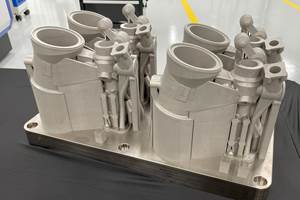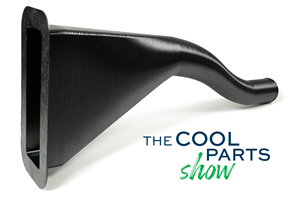Video: Safety Is No. 1 in Metal AM
John Murray of Concept Laser discusses safety, quality and automation as they relate to additive manufacturing for production metal parts.
In this conversation with AM, Concept Laser president and CEO John Murray describes the way an aerospace manufacturer tested to ensure that powder is contained within a powder-bed additive manufacturing system. “Safety is the most important aspect of all our systems and everything we do,” Murray says. He also describes advancing technology for monitoring and validation of the additive build, and the architecture of production systems based on additive technology.
Transcript:
Pete: I’m Pete Zelinski with Additive Manufacturing Magazine. I’m here with John Murray, the U.S. CEO and president of Concept Laser, a maker of powder bed additive manufacturing metal machines. John, machines that make metal parts through additive manufacturing, there’s some variation. Their differences in terminology that speak to differences in what these machines do, what is your company’s process and how is it different?
John: At a higher level, we just call if 3D printing just to keep it simple. But, as you mentioned, it’s a powder bed fusion process, so this is a fully dense process where you’re getting fully dense titanium aluminum steel parts and so forth.
Pete: It sounds easy and even watching the process, the part seems to come together almost by magic. But this is an industrial process and there are industrial hazards to it. What are the safety concerns of metal additive manufacturing and what are you doing to communicate that to potential users?
John: Yeah, we are absolutely right, safety is tantamount, is the most important aspect of all our systems and everything we do. It’s number one and that’s driven from Frankfurt Sardar CEO in Germany down. That’s a key part and he actually has made the architecture of all systems eight times compliant. That’s a European standard for potentially flammable or hazardous environments. We have one of our large aerospace customers do a rather extensive test. They were worried about bringing an m2 in and the environmental health and safety issues, so they put a sensor on the person’s collar. One on his waist, one at the sieving station and one on the entry door and they ran a number of alloys. They ran the light alloys, aluminum, for a while then they switched to Inconel and they were running Inconel then they checked all these sensors on it, you know? There was a bit of drama right, what’s gonna be in there? They didn’t find a trace of any powders or any soot or anything at any of these sensors and that gave them a tremendous confidence. That, yes, this process and the architecture that Frank has created is truly safe and can be run effectively and safely.
Pete: Had tremendous confidence about a very legitimate concern.
John: So we talked at the beginning when we address a customer out, what do you use for standard personal protection or extended personal protection? Depending on what step you’re doing in the process. So, we go all through that with our customers and they’re sometimes surprised because people don’t like to talk about it. You have to get in a suit, wear a respirator, and you know, you have to take it seriously.
Pete: Another important issue is consistency, repeatability, quality control, what kinds of information, what kinds of data can additive metal process provide, relate to quality control, and how’s your technology advancing in that area?
John: Almost a decade ago, Frank saw the need for this. You realized you have to be able to monitor the process and document the process, otherwise you’re making widgets right there. They’re beautiful widgets. Their metal widgets but that’s all they are, so he started with a product called QML Pool and we’ve just released the QML Pool 3D, so we’re looking directly through the laser into the powder bed into the melt pool and we’re measuring the intensity of the melt pool as well as the shape and area of the melt pool. We then compressed that data and we product a three-dimensional model of that entire build and that’ll show if there’s any porosity, if the laser went to sleep for two nanoseconds and we’re hoping that will help companies be able to certify their parts, whether that’s for the FAA or the FDA or any internal certification process, as they need. So, this three-dimensional model is just another augmentation of the process to get people confidence. They’re building quality fly free parts.
Pete: The adoption of additive is advancing rapidly, if you look forward, maybe just two years, in terms of additive manufacturing in North America, what do you see?
John: That’s a very good question. We have customers who are now ramping up and you know buying systems and groups of 20s or 30s now, so it’s changing from people buying one or two machines to experiment. We’re now there, really breaking out into production. Right now, the architecture is somebody has to go up and touch the machine. They have to start it, wait for it to finish, then come up to the machine afterwards and remove the part on packet we want to alleviate. All that so this is an architecture where it’s the factory of tomorrow. Or its all with autonomous vehicles with robots. Automations key and we’ve done that in our factory in Germany already. We’re moving forward with that factory of tomorrow architecture
Pete: Safety, repeatability, and quality, and even integration and automation. These are important concerns for manufacturing in general. They are the right issues for additive manufacturing as well as this technology increasingly enters mainstream production. Thank you, John.
John: Thank you Pete, we appreciate your time.
Related Content
Additive Manufacturing Is Subtractive, Too: How CNC Machining Integrates With AM (Includes Video)
For Keselowski Advanced Manufacturing, succeeding with laser powder bed fusion as a production process means developing a machine shop that is responsive to, and moves at the pacing of, metal 3D printing.
Read MoreThis Drone Bird with 3D Printed Parts Mimics a Peregrine Falcon: The Cool Parts Show #66
The Drone Bird Company has developed aircraft that mimic birds of prey to scare off problem birds. The drones feature 3D printed fuselages made by Parts on Demand from ALM materials.
Read MoreWhy AM Leads to Internal Production for Collins Aerospace (Includes Video)
A new Charlotte-area center will provide additive manufacturing expertise and production capacity for Collins business units based across the country, allowing the company to guard proprietary design and process details that are often part of AM.
Read MoreAircraft Ducts 3D Printed in Composite Instead of Metal: The Cool Parts Show #68
Eaton’s new reinforced PEKK, tailored to aircraft applications, provides a cheaper and faster way to make ducts compared to formed aluminum.
Read MoreRead Next
4 Ways the Education and Training Challenge Is Different for Additive Manufacturing
The advance of additive manufacturing means we need more professionals educated in AM technology.
Read MoreHybrid Additive Manufacturing Machine Tools Continue to Make Gains (Includes Video)
The hybrid machine tool is an idea that continues to advance. Two important developments of recent years expand the possibilities for this platform.
Read More3D Printing Brings Sustainability, Accessibility to Glass Manufacturing
Australian startup Maple Glass Printing has developed a process for extruding glass into artwork, lab implements and architectural elements. Along the way, the company has also found more efficient ways of recycling this material.
Read More





















